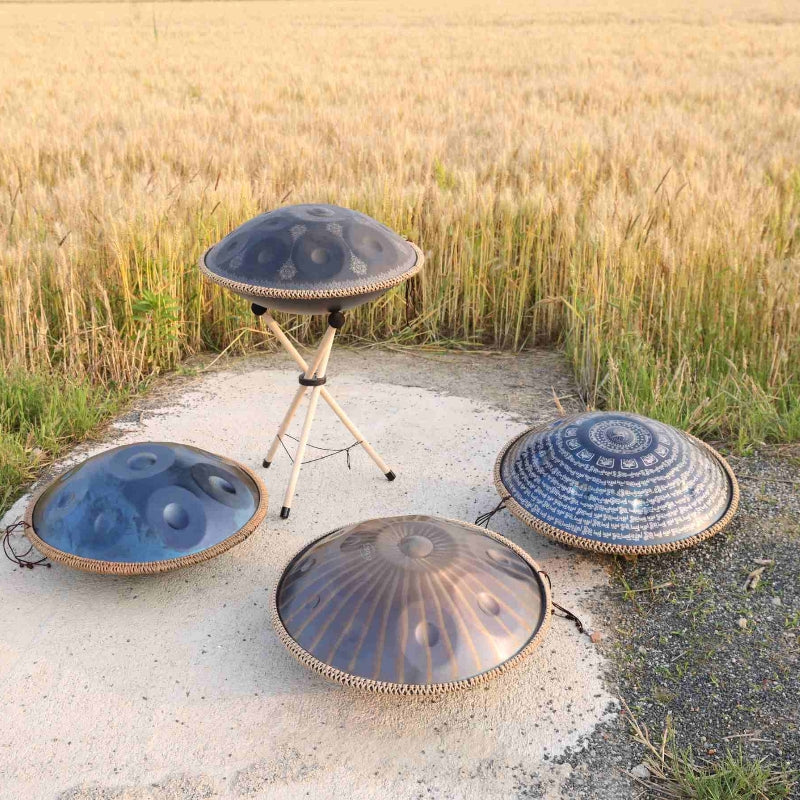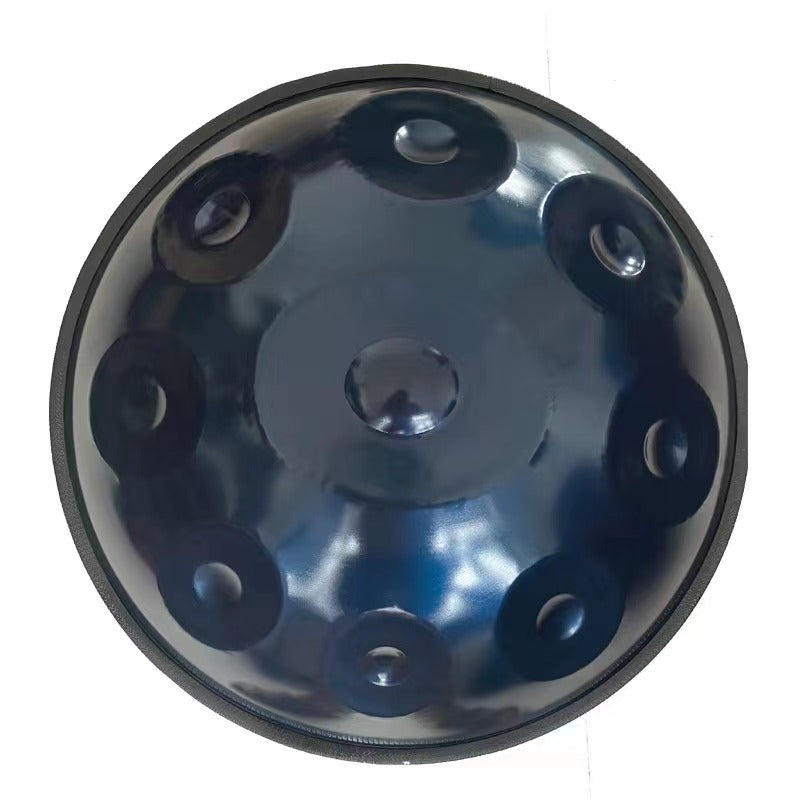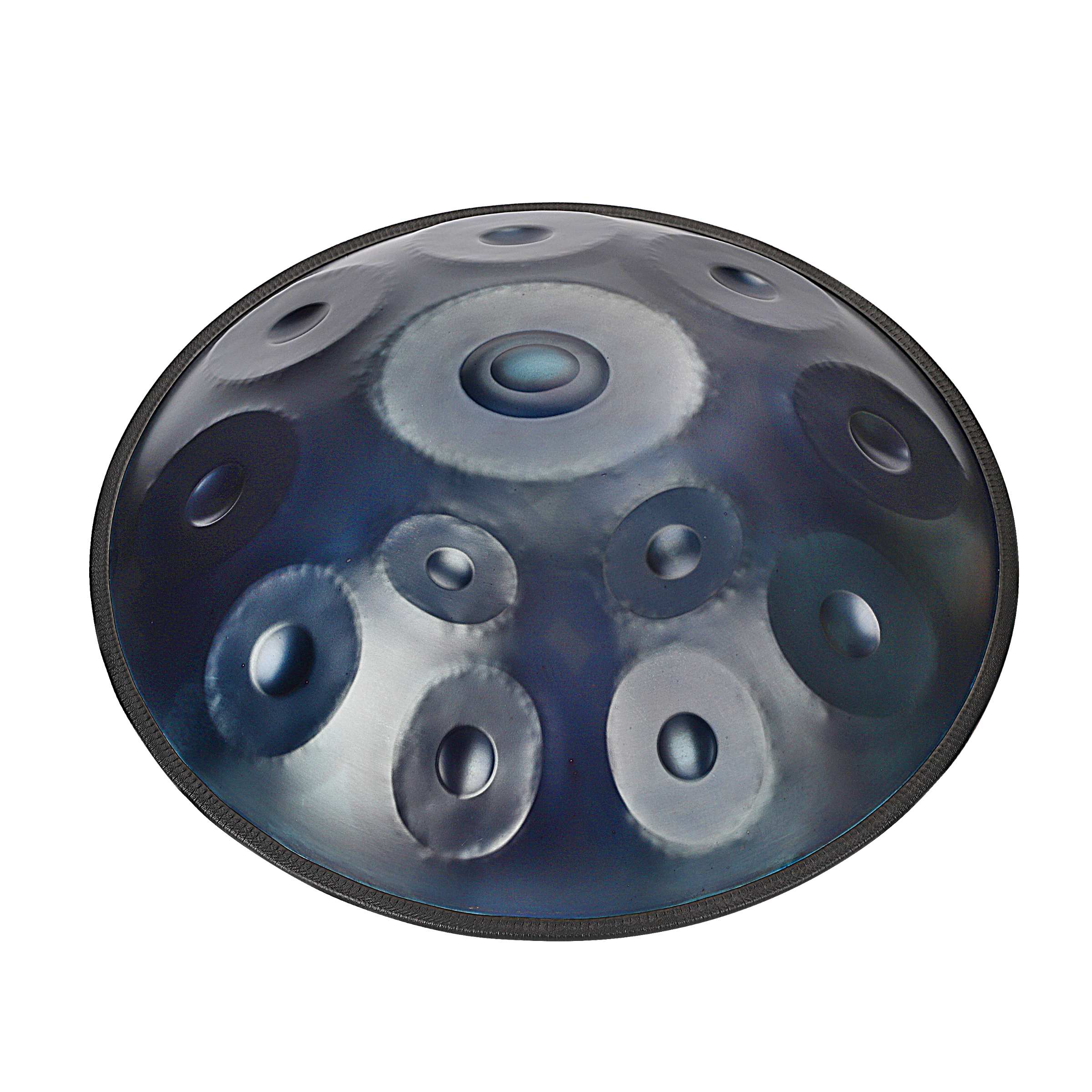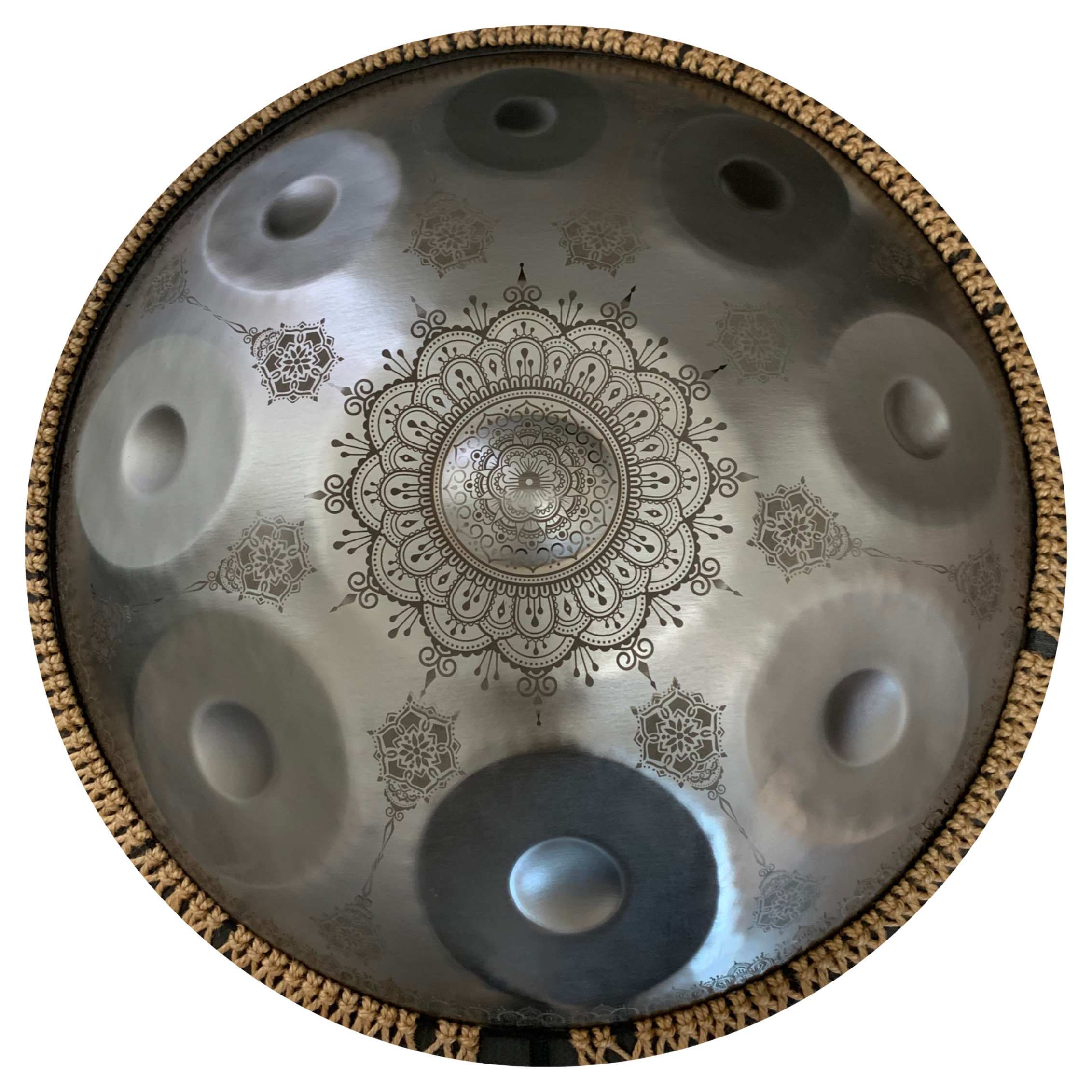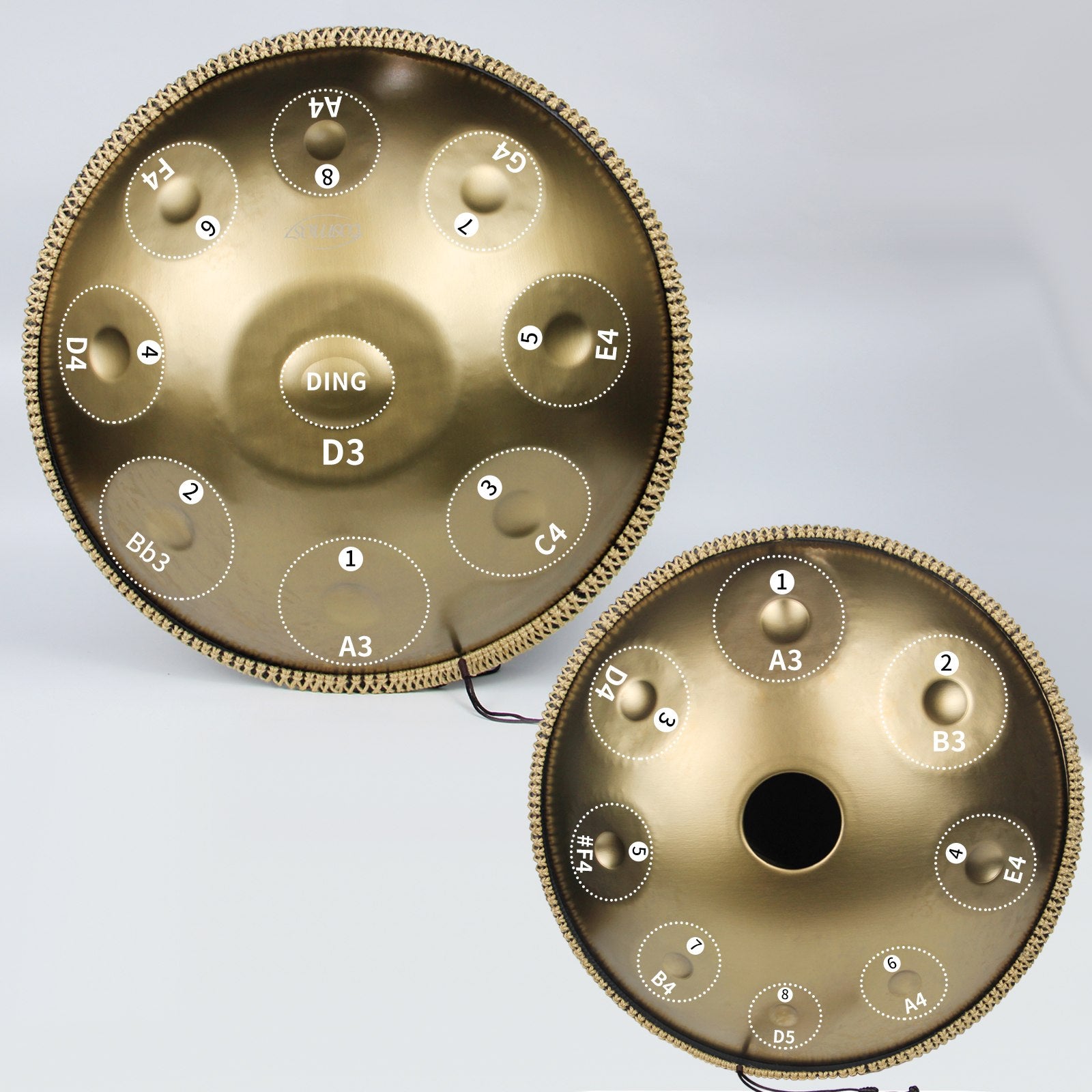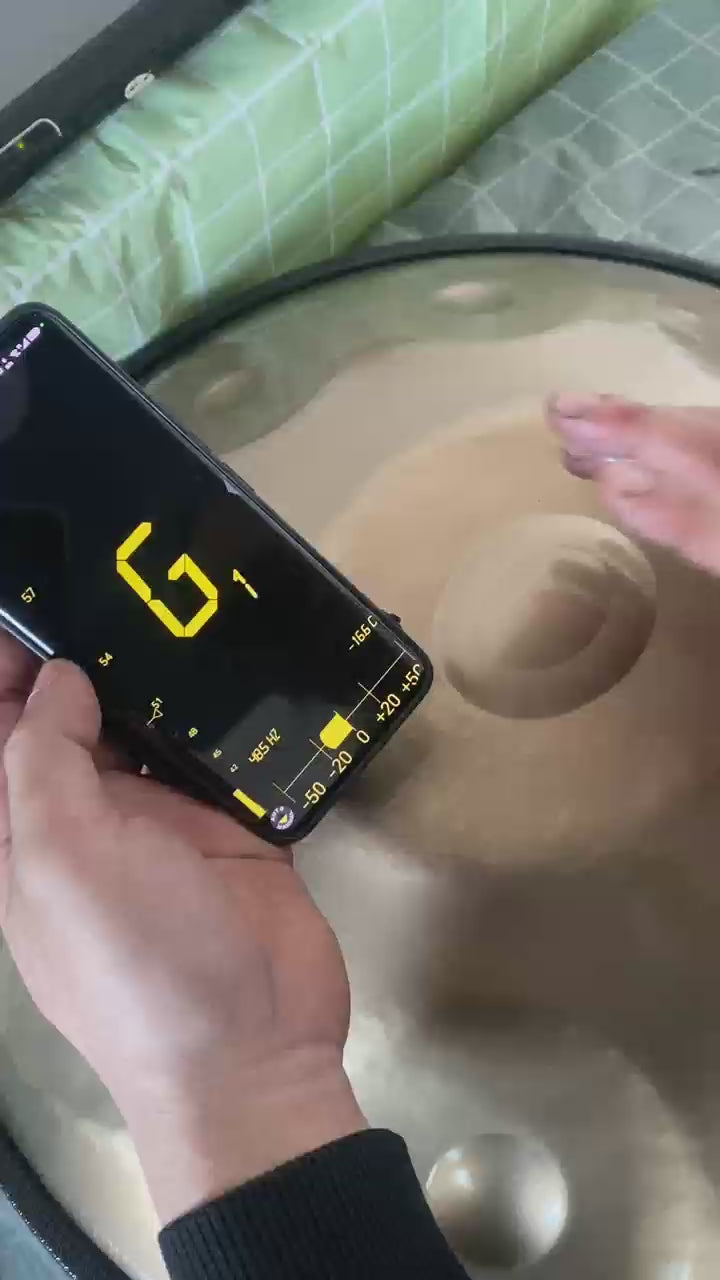This is the best advice for first time handpan buyers!
1)What's handpan?
A handpan is a steel percussion instrument that produces melodic, soothing sounds. Swiss craftsmen developed it in the early 2000s. Players hit the handpan with their hands to produce various musical sounds, giving it the appearance of a UFO. People often use it in meditation, yoga, and musical performances because of its calming and unique sound.
People play the handpan by hand or with specific mallets. The arrangement of the notes makes improvisation easy and intuitive, making it an excellent choice for beginners. This is one of the reasons for its growing success. To make the right choice of handpan, it is important to understand the particularities of the handpan range.
2)Learn about handpan
People often tune the handpan to a simple scale, which makes it easy for beginners to learn. You can start playing the handpan even without any musical experience.
2.1)What are the different scales of handpan
Each type of scale produces different tones that can evoke different emotions and musical moods. There are many different types of handpieces. The major and minor scales are the most common. The major scale sounds happy and positive, while people often see the minor scale as sad or somber.
THE MAJOR SCALE IN VIDEO
THE MINOR SCALE IN VIDEO
Of course, there is no best or worst handpan range. The choice depends entirely on your personal preferences and the style of music you want to play. We recommend that you listen to the different scales and choose the one that touches you the most.
2.2)Which scale should a beginner choose?
For beginners, we usually recommend
D minor. The scale is easy to learn and versatile, making it great for beginners starting their musical journey with a handpan. Musicians like D minor for its sad and lively sound, letting you express many feelings when you play music.
Choosing the right handpan scale is crucial. However, keep in mind that there is no perfect option for everyone. The most important thing is to find a range that resonates with you and allows you to express yourself. Enjoy your exploration of the handpan range!
3)What is the frequency of handpan? Should I choose 432HZ or 440HZ?
The most commonly used frequencies for handpan are 432 HZ and 440 HZ, and the choice of frequency can be confusing for beginners. So let's sort out the key differences between these two values.

3.1)432HZ frequency presentation
The frequency at which the hand dial tunes to 432 Hz is called the "intrinsic frequency." This value is in perfect harmony with the universe and surrounding nature. It provides a soothing sensation and promotes relaxation and meditation. For many musicians, the 432 Hz frequency promotes a more intense emotional experience and a sharp artistic intuition.

Many handpanels are set to the same frequency, so you can play music with others without any issues.
3.2)440 HZ frequency presentation
The standard frequency for most modern instruments, including the handpan, is 440 Hz. It is also the reference frequency for tuning symphony orchestras. Playing an instrument tuned to 440 Hz is beneficial for playing with other musicians in various settings. This includes live shows and playing alongside different instruments. It helps ensure that all musicians are in sync and playing in harmony. This standard tuning allows for seamless collaboration and a cohesive musical performance.
However, the 440Hz frequency is considered more intense and dynamic. For some, it may even seem unnatural compared to the inherent frequency of 432Hz. The decision between these two frequencies ultimately depends on the musician's personal preference.
3.3)Listen and choose your preferences
Our suggestions can guide you. However, what is most important to guide you in your choice is the feeling that different handpan gives you. Please listen to the handpan that makes you feel the best on YouTube or our website's soundtrack. Take the time to enjoy it.
Playing a handpan should give you a deep sense of well-being, relaxation and meditation. Each instrument is unique, just like you. Therefore, do not ignore your preferences compared to the suggestions you find on the Internet.
4)Handpan's sustain
The sustain of a handpan is the length of time that a note resonates after it has been struck. It is a key element in creating the rich soundscape character of the instrument. Longer sustain provides deeper resonance and more room for harmonic experimentation. However, too long a duration can lead to unwanted sound mixing, which should be avoided.
4.1)Ideal sustain for beginners
As a handpan beginner, a handpan that offers medium sustain is ideal. This provides enough time for the notes to resonate and for the percussive technique to take hold without having to mix the sounds. Shorter sustains can be difficult for beginners to master, while longer sustains require better technique to avoid “masking” notes.
As you progress and learn to manage sustain, you can begin to explore handpieces with longer sustain. Ultimately, the choice of sustain depends on your personal taste and playing style.
5)Manufacturing materials
The material used to make a handpan affects how it sounds, how long it lasts, and how much it costs. handpans can usually be made from various types of steel, the most common of which are nitrided steel and stainless steel.

Different materials produce different sounds. For example, nitrided steel sounds slightly warmer than stainless steel. So the choice of material depends a lot on your personal sound preferences.
5.1)Nitrided steel vs. stainless steel
Nitrided steel is valued for its corrosion resistance and durability. It is treated with nitrogen to create a tough protective layer. This gives the handpan a richer, deeper sound with beautiful overtones.
Stainless steel is good at resisting corrosion, but it has a brighter sound and doesn't sustain well. This makes the handpan more suitable for playing fast, rhythmic music.
5.2)What material should a beginner choose?
The type of steel you choose for your handpan depends on the needs of the beginner. If you prefer a richer sound and deeper overtones, nitrided steel may be a better choice. However, if you prefer a brighter sound and more rhythmic playing, stainless steel may be more appropriate.
Beginners should try out handpans made of various materials to find the sound they prefer. Testing is important for discovery. Stainless steel is typically cheaper than nitrided steel, which could impact your decision.
6)How to choose the number of notes?
Have you taken the time to listen to several handpan sounds to carefully select your range? Now let's move on to selecting the number of notes on the instrument. The number of notes will define the range of the melodic universe in which you are working with the handpan.
Important note: There are several ways to count the notes of a handpan. For example, some sellers (like us) will write “9 notes” for a handpan with 8 notes + ding (center note). Others do not include this center note, but write 8 + 1.
6.1)Handpan of 9 notes
There are a lot of handpan today with very few notes (less than 9 including the ding). Keep in mind that a few notes does not mean that you will soon be limited by the number of sounds you can make. In fact, there are many ways to create sounds with the same notes.
That's why, based on our experience, we strongly recommend that you choose the 9-note handpan. This will help you get started quickly with your new instrument. Don't forget that the handpan is an intuitive instrument that can be played without knowledge or improvisation!
6.2)Handpan over 10 notes
This selection is designed for those who wish to explore a wider range of musical horizons. You will be able to play many melodies while learning more and more techniques. In general, we recommend this selection for those who have already played and learned handpan. If you are an intermediate or expert, go for it!
7)How to choose colors for handpan?
The color of the handpan is based on personal preference and does not impact the sound of the instrument. Handplates come in a variety of colors, from matte black to shiny metallic finishes, bronze and antique brass. In addition to being aesthetically pleasing, colors have maintenance implications. For example, a darker finish may leave more fingerprints and require more frequent maintenance.

In the end, the hue of the handpan should mirror your individual preference. If you admire the elegance of a matte black handpan, go for it. If you're drawn to the luster of bronze or copper, select this instrument. Ultimately, you're the one who will be using and relishing the instrument every day. Hence, the color you opt for should delight you and motivate you to play.
8)Tips for buying your first handpan
Buying a handpan can be overwhelming for beginners due to the many options and seller reliability concerns. That's why the Cosmoshandpan team is here to help you!
Whether before, during or after your purchase, our team is at your disposal and you can contact us here.
We provide a 12-month warranty and a 14-day return policy for your Handpan purchase. You can return it to us for a full refund within 14 days.
9)Summary of the 5 basic criteria for selecting the first handpan
To summarize, there are several basic criteria for choosing your first handpan. The following list summarizes the important criteria you must consider:
- First of all, choosing the right scale is important for your musical satisfaction.
- Next, choose between the two main resonant frequencies, 432Hz and 440Hz, depending on your personal sound preferences. Also, pay attention to sound quality, especially in terms of sustain, note balance and crosstalk.
- The material of construction is also a key consideration, with each steel having unique acoustic properties.
- The number of notes affects your playing experience and should be chosen according to your skill level.
- Finally, aesthetic details such as color are subjectively important, but can detract from your enjoyment of playing handpan.
10)Vocabulary to learn before you start
The handpan is known by many names such as hangpan, hangdrum, pantam, and more.
The word "Hang" and its synonyms all come from the PANArt company, who created the first instruments. They patented the name and did not want it to be used to describe the instrument family.
Some expressions to know:
- Ding=The center note of a musical instrument
- dimples=In the middle of the different notes
- Gu=Hole located below the handpan for amplification and bass production
- Shoulder sound is the highest harmonics played by touching the edge of the note, tuned in relation to the center note.
- bottom note=All the notes found on the chassis
- Maker / Tuner= Manufacturer of handpan
11)FAQs
11.1)What is the rationale behind handpan's reasonable prices?
The price of a handpan depends largely on the cost of the materials used, the time taken to make it and the expertise required. Each instrument is unique and needs hours of hand work to achieve a harmonious sound. Handpans that are handmade by artisans are usually more expensive, but have a better sound quality.
11.2)Is the handpan difficult to play?
The handpan is characterized by its ability to be improvised. In fact, it is an intuitive instrument that can be played by hand or with mallets (sticks). For this reason, try to always maintain a distinctive rhythm to create a harmonious melody. You can obviously speed it up or slow it down to your liking.
If you want to know how to learn handpan, we strongly recommend browsing the Internet. You'll find tons of free explanatory videos on Facebook groups or forums, as well as tons of blog posts and advice. A big group of people love the handpan and can help you learn it slowly with expert tips.
12)conclude
As you have noticed, choosing your first handpan is a task to be taken seriously. When choosing your sound preferences, consider factors like quality, number of notes, and scale choices. Trust your own judgment.
There's no rush, so take your time, that's the best advice we can give you.

